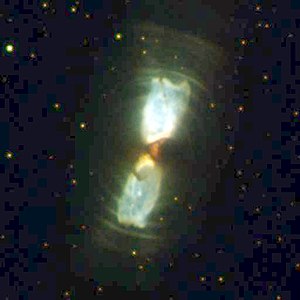astro.wikisort.org - Nebulosa
La nebulosa Algodón de Azúcar (en inglés Cotton Candy Nebula) es una protonebulosa planetaria situada en la constelación de Scorpius, el escorpión. Este tipo de nebulosas constituye un breve episodio de la evolución estelar entre la fase final de la rama asintótica gigante y la transformación en una verdadera nebulosa planetaria. La nebulosa Algodón de Azúcar es conocida formalmente como IRAS 17150-3224, ya que fue descubierta por el observatorio espacial de infrarrojos IRAS.
| Nebulosa Algodón de Azúcar | ||
|---|---|---|
 | ||
| Datos de observación: Época J2000.0 | ||
| Ascensión recta | 17h 18m 19.9s[1] | |
| Declinación | -32° 27′ 22"[1] | |
| Distancia | ? | |
| Magnitud aparente (V) | 14,4[1] | |
| Constelación | Scorpius | |
| Características físicas | ||
| Otras designaciones |
IRAS 17150-3224, RAFGL 6815S | |
La imagen obtenida con el telescopio espacial Hubble permite ver una serie de anillos concéntricos que representan los distintos episodios de material expulsado por la estrella central en los últimos miles de años. Después de una serie de estos episodios, la estrella ha quedado encerrada en un "capullo"; en la imagen se observan los primeros indicios que muestran a la nebulosa emergiendo del capullo.[2]
Véase también
- Lista de protonebulosas planetarias
Referencias
На других языках
[de] IRAS 17150-3224
IRAS 17150-3224 im englischen auch Cotton Candy Nebula ist ein a präplanetarischer Nebel im Sternbild Altar, der mithilfe des IRAS-Satelliten entdeckt wurde.[en] Cotton Candy Nebula
The Cotton Candy Nebula is an astronomical object in the constellation of Scorpius. It is considered to fall into an unusual category of nebulae known as protoplanetary nebulae or post-AGB stars.[1] A proto-planetary nebulae is an astronomical object that is in a stellar evolution phase where the star begins to discard its outer layers and is about to proceed to becoming a true planetary nebula, which is another astronomical object made up mostly of gaseous materials that was originally discovered by the IRAS satellite. IRAS was launched in January 1982 and overlooked about 97 percent of the sky.[2] It is also known as IRAS 17150-3224. It is a good example of a DUPLEX-type protoplanetary nebula.[3]- [es] Nebulosa Algodón de Azúcar
[ru] Туманность Сахарная Вата
Туманность «Сахарная Вата» — протопланетарная туманность, связанная со звездой, находящейся на стадии после асимптотической ветви гигантов.[3] Протопланетарная туманность представляет собой астрономический объект на такой стадии звёздной эволюции, при которой звезда начинает сбрасывать внешние слои и постепенно переходит к стадии планетарной туманности. Впервые наблюдалась космическим аппаратом IRAS. IRAS был запущен в январе 1982 года и впоследствии наблюдал около 97% неба.[4] Объект также известен как IRAS 17150-3224. Туманность является примером протопланетной туманности типа DUPLEX.[5]Другой контент может иметь иную лицензию. Перед использованием материалов сайта WikiSort.org внимательно изучите правила лицензирования конкретных элементов наполнения сайта.
WikiSort.org - проект по пересортировке и дополнению контента Википедии